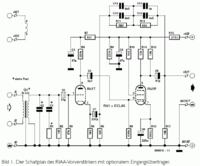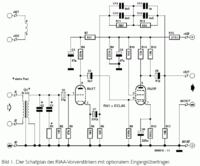I have the opportunity to buy a DIY preamplifier (infinite - no housing) on PCL86 lamps.
Description of the amplifier:
"amateur-made and well-functioning stereo preamplifier with RIAA correction characteristics for turntables with MM insert, made on PCl86 tubes." Preamplifier without casing and mechanical construction components Component set Complete and efficient Riaa preamplifier board with PCL86 elements and lamps Anodic power supply board + 300V. Power supply lamp board with 300mA current stabilizer Power transformer about 50W 220 / 250V-125mA, 28V-0.4A For this design is documentation of connections and schemes according to which this preamplifier was made. Pre-amplifier made on these lamps It is possible to mount this preamplifier inside the power amplifier, and mount it in an interesting housing. The PCB with the preamplifier and the power supply made by printing (hand-drawn), correction elements on the universal board, glow plug board on the universal board. with behavior m safety rules (it has one carcase corner removed, which has no effect on the parameters and use goes). General dimensions: 13 / 8cm / high pre-amplifier plates with 5.6cm elements. With 13cm tubes. 6.3cm lamp spacing. Mounting holes 11.8 / 6.8cm.fi.5.5. Anode power supply plates 8.7 / 5.1cm / height 3.5cm. Set open montaz.8 / 4,5cm.fi.3mm. Glowing plates 6,7 / 2,3cm / height 4cm. Transformatory outline marker 8.5 / 7cm / height.8cm. "
Description, description, but I asked a few questions of the seller, below the questions and answers:
1- what was the preamplifier modeled on?
Ad.1 - on the German construction, I found a diagram on the net. Elektor magazine. The board adopted from EDW 01-2005.
2- steaming lamps?
Ad. 2- no, but the voltages on the anodes vary in the order of 2V.
3- lamp operation adjusted?
Ad. 3- no, but the values of the elements resistors in accordance with the diagram. Electrolytes in the order of capacity wolfness. the power supply is also compatible.
And here is my question: how do you view such a construction?
Is it right to play well? I do not have the opportunity to listen before buying ...

Description of the amplifier:
"amateur-made and well-functioning stereo preamplifier with RIAA correction characteristics for turntables with MM insert, made on PCl86 tubes." Preamplifier without casing and mechanical construction components Component set Complete and efficient Riaa preamplifier board with PCL86 elements and lamps Anodic power supply board + 300V. Power supply lamp board with 300mA current stabilizer Power transformer about 50W 220 / 250V-125mA, 28V-0.4A For this design is documentation of connections and schemes according to which this preamplifier was made. Pre-amplifier made on these lamps It is possible to mount this preamplifier inside the power amplifier, and mount it in an interesting housing. The PCB with the preamplifier and the power supply made by printing (hand-drawn), correction elements on the universal board, glow plug board on the universal board. with behavior m safety rules (it has one carcase corner removed, which has no effect on the parameters and use goes). General dimensions: 13 / 8cm / high pre-amplifier plates with 5.6cm elements. With 13cm tubes. 6.3cm lamp spacing. Mounting holes 11.8 / 6.8cm.fi.5.5. Anode power supply plates 8.7 / 5.1cm / height 3.5cm. Set open montaz.8 / 4,5cm.fi.3mm. Glowing plates 6,7 / 2,3cm / height 4cm. Transformatory outline marker 8.5 / 7cm / height.8cm. "
Description, description, but I asked a few questions of the seller, below the questions and answers:
1- what was the preamplifier modeled on?
Ad.1 - on the German construction, I found a diagram on the net. Elektor magazine. The board adopted from EDW 01-2005.
2- steaming lamps?
Ad. 2- no, but the voltages on the anodes vary in the order of 2V.
3- lamp operation adjusted?
Ad. 3- no, but the values of the elements resistors in accordance with the diagram. Electrolytes in the order of capacity wolfness. the power supply is also compatible.
And here is my question: how do you view such a construction?
Is it right to play well? I do not have the opportunity to listen before buying ...




